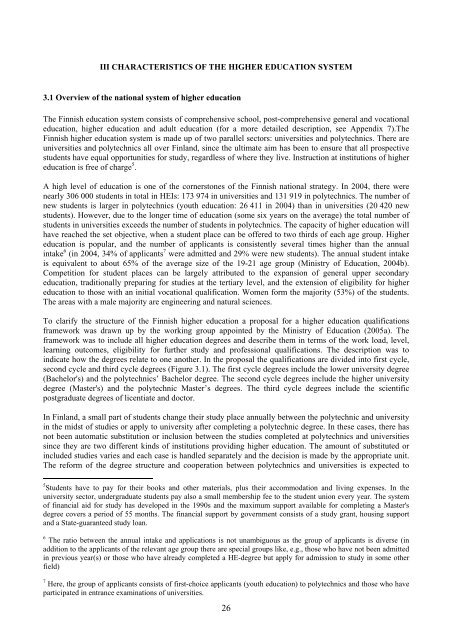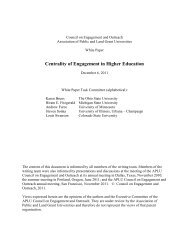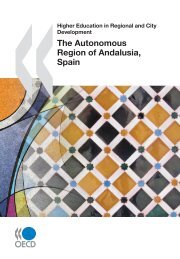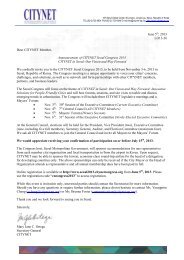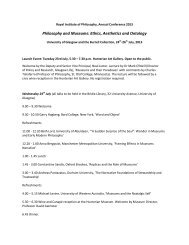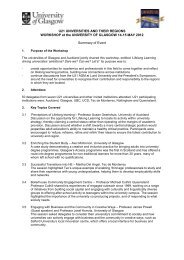Finland - Jyvaskyla Region - Final Self-Evaluation Report.pdf
Finland - Jyvaskyla Region - Final Self-Evaluation Report.pdf
Finland - Jyvaskyla Region - Final Self-Evaluation Report.pdf
Create successful ePaper yourself
Turn your PDF publications into a flip-book with our unique Google optimized e-Paper software.
III CHARACTERISTICS OF THE HIGHER EDUCATION SYSTEM3.1 Overview of the national system of higher educationThe Finnish education system consists of comprehensive school, post-comprehensive general and vocationaleducation, higher education and adult education (for a more detailed description, see Appendix 7).TheFinnish higher education system is made up of two parallel sectors: universities and polytechnics. There areuniversities and polytechnics all over <strong>Finland</strong>, since the ultimate aim has been to ensure that all prospectivestudents have equal opportunities for study, regardless of where they live. Instruction at institutions of highereducation is free of charge 5 .A high level of education is one of the cornerstones of the Finnish national strategy. In 2004, there werenearly 306 000 students in total in HEIs: 173 974 in universities and 131 919 in polytechnics. The number ofnew students is larger in polytechnics (youth education: 26 411 in 2004) than in universities (20 420 newstudents). However, due to the longer time of education (some six years on the average) the total number ofstudents in universities exceeds the number of students in polytechnics. The capacity of higher education willhave reached the set objective, when a student place can be offered to two thirds of each age group. Highereducation is popular, and the number of applicants is consistently several times higher than the annualintake 6 (in 2004, 34% of applicants 7 were admitted and 29% were new students). The annual student intakeis equivalent to about 65% of the average size of the 19-21 age group (Ministry of Education, 2004b).Competition for student places can be largely attributed to the expansion of general upper secondaryeducation, traditionally preparing for studies at the tertiary level, and the extension of eligibility for highereducation to those with an initial vocational qualification. Women form the majority (53%) of the students.The areas with a male majority are engineering and natural sciences.To clarify the structure of the Finnish higher education a proposal for a higher education qualificationsframework was drawn up by the working group appointed by the Ministry of Education (2005a). Theframework was to include all higher education degrees and describe them in terms of the work load, level,learning outcomes, eligibility for further study and professional qualifications. The description was toindicate how the degrees relate to one another. In the proposal the qualifications are divided into first cycle,second cycle and third cycle degrees (Figure 3.1). The first cycle degrees include the lower university degree(Bachelor's) and the polytechnics’ Bachelor degree. The second cycle degrees include the higher universitydegree (Master's) and the polytechnic Master’s degrees. The third cycle degrees include the scientificpostgraduate degrees of licentiate and doctor.In <strong>Finland</strong>, a small part of students change their study place annually between the polytechnic and universityin the midst of studies or apply to university after completing a polytechnic degree. In these cases, there hasnot been automatic substitution or inclusion between the studies completed at polytechnics and universitiessince they are two different kinds of institutions providing higher education. The amount of substituted orincluded studies varies and each case is handled separately and the decision is made by the appropriate unit.The reform of the degree structure and cooperation between polytechnics and universities is expected to5 Students have to pay for their books and other materials, plus their accommodation and living expenses. In theuniversity sector, undergraduate students pay also a small membership fee to the student union every year. The systemof financial aid for study has developed in the 1990s and the maximum support available for completing a Master'sdegree covers a period of 55 months. The financial support by government consists of a study grant, housing supportand a State-guaranteed study loan.6 The ratio between the annual intake and applications is not unambiguous as the group of applicants is diverse (inaddition to the applicants of the relevant age group there are special groups like, e.g., those who have not been admittedin previous year(s) or those who have already completed a HE-degree but apply for admission to study in some otherfield)7 Here, the group of applicants consists of first-choice applicants (youth education) to polytechnics and those who haveparticipated in entrance examinations of universities.26


